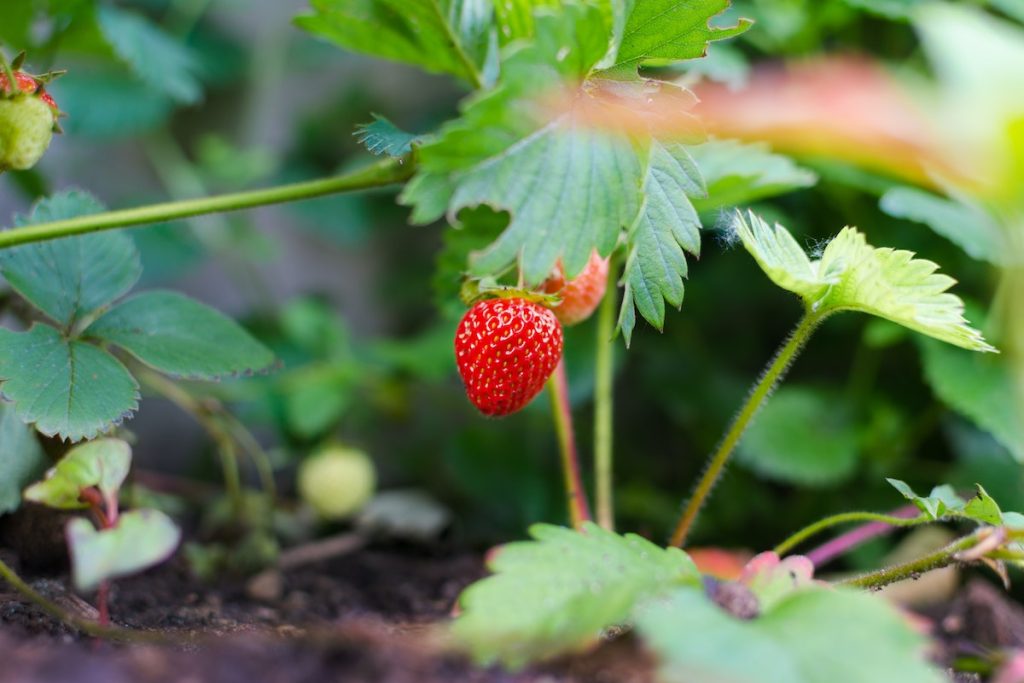- There are 3 strawberry varieties: June-bearing, ever-bearing, and day-neutral strawberries, and each comes with a unique set of features.
- A strawberry’s life cycle includes seeding, germination, sprouting, seedling, flowering, fruits, runners and ends with mature plants.
- Learning about strawberry plants helps you grow your strawberries better and ensures you troubleshoot pests or other growth hinders.
- A healthy strawberry plant is deeply rooted to the ground, has glowy leaves, and too many flowers during the flowering stage.
Being familiar with the strawberry life cycle is necessary to plant strawberries recreationally in your yard, but it is essential to grow strawberries as a business. The weeds that suppress the growth of the strawberry almost all look exactly as the strawberry plant leaves. This is why educating yourself on the strawberry growth phases is crucial.
To help you learn what to expect during each growth phase, we compiled a list of questions to answer:
- What do strawberry sprouts look like?
- What does a strawberry plant look like?
- What do strawberry seedlings look like?
- What do strawberry plants look like when they sprout?
Know About Strawberry Plant Varieties
You can easily distinguish strawberries from other berries. However, many strawberry plant subcategories exhibit different features in
terms of fruit, leaves, or flowers that make all the difference.
Before you plant strawberries, you should learn more about the existing varieties and their specific features:
-
- June-bearing strawberries: These strawberries are the most popular. They have plump red fruits that grow in width and a juicy texture that makes them ideal for desserts or breakfast dishes.
- Ever-bearing strawberries: These strawberries are recognizable for their small shape and have a meaty and juicy texture. Ever-bearing strawberries have a characteristic sweet flavor many love.
- Day-neutral strawberries: This elongated and sturdy fruit with a vivid red color has a pointy and straight shape. Day-neutral strawberries have hairy and green leaves and are the type of strawberry most opted for display on fountains, salads, or other fruit decorations.
Strawberry Plant Life Cycle
The strawberry plant life cycle has 7 stages. It starts slow but develops fast after sprouting. Here is a closer look at each stage:
-
- Seedling: The first stage requires planting the seeds in appropriate soil and depth. This will help stimulate the healthy growth of the strawberry plant. The seed takes around 1-8 weeks to settle in the soil.
- Germination: Once settled, the germination process begins when roots start growing by feeding on the soil nutrients.
- Sprout: After the 10th week, the plant will display little fuzzy green leaves above the soil, which suggests that the plant grows healthy. This is the stage where you plant the strawberries outside if you have seeded them indoors.
- Vegetative growth: The plant starts expanding in a bushy fashion. The leaves will become vivid green and soft to the touch. You will notice a healthy glow or shine in the leaves.
- Flowering: The time between the 12th and 14th week is all about flowering and waiting for the bees. The leaves of the strawberry plant gain that dark green color and begin flowering.
- Fruits and runners: At this point, you will start noticing the first fruits. During this stage, they are green and mossy, with red seeds. Additionally, you should expect runners to start growing from the stem. Do not pick on them, and they will grow and help you expand your garden.
- Mature plant: This is the final stage of the life cycle. The fruits are red with yellow seeds, the leaves are dark green, and the harvesting may begin.
What Do Strawberry Plants Look Like?
Knowing each part of the plant and its characteristics, features, and traits will help you feel confident in strawberry plant identification. So, what does a strawberry plant look like? Strawberries have fragile stems, which is why they grow up to 6 inches. The crown of the plant – or the bush – has stems, flowers, and fruits, but also runners after fruiting. Runners are mini strawberries that can grow once they touch the ground.
Below, we briefly explain other parts of the strawberry plant you need to know.
What does a strawberry leaf look like?
Strawberry leaves have noticeable dark green leaves with a central vein that spreads from the stem to the tip of the leaf. The leaves grow from each stem in a cloverleaf manner. They have a sawtooth-blade-like edging and an average rounded shape. The healthy leaves will have a glossy effect.
What does a strawberry seedling look like?
Strawberry seedlings usually take 2-3 weeks until they germinate. However, the first sign that the strawberry grows successfully is the appearance of fuzzy leaves. This is what a strawberry seedling looks like.
What do strawberry flowers look like?
Strawberry flowers usually have 5 white petals, but some strawberry varieties have 8 and are usually pinkish in color. Pollen-bearing stamens surround a yellow or white pistil in the middle.
What do strawberry fruits look like?
Ripe strawberries have a vivid red color with yellow seeds and are soft to the touch. If the strawberry fruit has reddish seeds, white spots on the fruit, and is sturdy to the touch – they are still not ready for harvesting.
Importance of Understanding Strawberry Plant Appearance
Identifying the strawberry plant’s appearance is crucial for the plant’s healthy growth. Any recreational or professional grower should be familiar with the plant’s appearance for the following reasons:
- Identifying Healthy Plants: The leaves of a healthy strawberry plant glow. It doesn’t make a huge difference in taste if the plant doesn’t have this glow, but the growth rate and number of fruits will be affected significantly. Expect slowed growth if you cannot spot any healthy issues and end up with less-than-expected fruits.
- Diagnosing Potential Issues: Being familiar with the looks of a healthy plant will help you identify potential issues with the plant. For example, weeds have a similar appearance as the strawberry plant leaves, and if you do not remove them immediately – you will suppress the growth of the strawberry.
- Offering Proper Care: Not recognizing a healthy strawberry plant prevents you from offering proper care and growth of the strawberry. Sometimes, the same strawberry variety has different watering requirements. If you don’t know about the factors that influence the scheme of watering strawberries, you may end up wilting the plant.
Tips for Identifying Healthy Strawberry Plants
Identifying healthy strawberry plants is easy if you know where and what to look for. Here are a few tips on the signs suggesting optimal strawberry growth:
- Sturdy roots: Your strawberry plant should be literally rooted to the ground if everything’s okay. In other words, when gently pulling on the strawberry, the plant should stay in place, and the roots should not break.
- Glowy dark green leaves: Healthy strawberry plants have dark green leaves with a glowy finish. It’s hard to miss this sign.
- Flower production: If you notice too many flowers on your strawberry plant, your plant is healthy and ready for the next stage. More flowers mean juicier strawberries.
- No pests or diseases: If you plant your strawberries on the ground, be aware of the common soil pests that can destroy your plant. Make sure you regularly check for snails, worms, or other pests that can damage or infect your plant.
Common Mistakes in Identifying Strawberry Plants
Some of the common mistakes people make in strawberry plant identification include the following:
- Mistaking the runners for weeds: Many people repeat this mistake as runners really look like a weed that grew below the crown of the strawberry. To “prevent” further damage or repress the plant, the grower would take out the runner and affect the growth and reproduction of the strawberry. Before you weed your plants, make sure you learn everything about the normal and healthy look of the strawberry plant to avoid inflicting unnecessary damage.
- Not taking off brownish leaves: Usually, during the spring, the strawberry’s flowers will wilt and fall on their own. However, that’s not the case with the leaves. If you notice that your leaves have a browning color and are wilting away – this means that they are infected and may kill the plant if you don’t remove them.
Strawberries may seem easy to cultivate because they are small, but regardless of their size, they require special attention to grow healthy.

Conclusion
Strawberry cultivators have to know all strawberry varieties so they can find the strawberry that matches the soil and growing area. All strawberries have a 7-stage life cycle, and each stage requires special attention and monitoring to see if the plant develops correctly.
Not being able to recognize a strawberry plant hinders its growth as you will not be able to recognize potential diseases, pests, or signs of sickness and help the plant. As a result, you will end up with small strawberries for the variety, fewer fruits than expected, or, in the worst case, a wilted plant.




